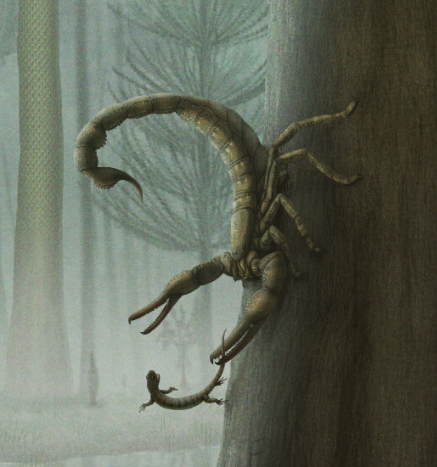Pulmonoscorpius (Breathing Scorpion)
Basic facts
28 inches (0.7m) length
Early Carboniferous
Scotland
Carnivore
Description
Pulmonoscorpius, an extinct scorpion genus, inhabited the Mississippian period (Early Carboniferous) of Scotland. Its sole designated species is Pulmonoscorpius kirktonensis. This scorpion ranks among the largest ever recorded, with the largest individual estimated to surpass 70 cm (28 inches) in length. Unlike contemporary scorpions, Pulmonoscorpius maintains a set of general arthropod characteristics, including prominent lateral eyes and a lack of adaptations suited for burrowing. This scorpion likely functioned as an active diurnal predator, and its possession of book lungs suggests a fully terrestrial lifestyle.
Pulmonoscorpius likely attained its substantial size due to the elevated oxygen levels during the Carboniferous era. While Pulmonoscorpius closely resembles modern scorpions in overall appearance, its relatively larger eyes suggest a potentially heightened reliance on visual hunting.
The toxicity of Pulmonoscorpius' venom remains uncertain, yet a general guideline is that venom potency tends to increase as the size of pincers in relation to tail thickness decreases. In contemporary scorpions, those with diminutive pincers and robust tails instill greater fear among individuals familiar with their presence. This principle potentially applies to Pulmonoscorpius as well.
Diet and feeding habit
Determining Pulmonoscorpius' precise diet is a challenge, but given its scorpion nature, it is highly likely that it was carnivorous. Its preferences could have centered on larger arthropods, and perhaps even smaller amphibians and early reptiles. A potential clue lies in the comparatively modest size of its pincers, suggesting a specialization in either smaller prey or a reliance on venom to incapacitate larger targets, subsequently utilizing its pincers for manipulation after their demise.
